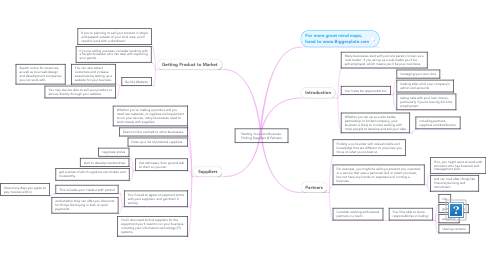
1. Introduction
1.1. Many businesses start with just one person, known as a ‘sole trader’. If you set up as a sole trader you’ll be self-employed, which means you’ll be your own boss.
1.2. You’ll also be responsible for:
1.2.1. managing your own time
1.2.2. looking after all of your company’s admin and accounts
1.2.3. taking risks with your own money, particularly if you’re leaving full-time employment
1.3. Whether you set up as a sole trader, partnership or limited company, your business is likely to involve working with more people to develop and sell your idea
1.3.1. including partners, suppliers and distributors.
2. Partners
2.1. Finding a co-founder with relevant skills and knowledge that are different to yours lets you focus on what you’re best at.
2.2. For example, you might be selling a product you invented, or a service that uses a particular skill or talent you have, but not have any hands-on experience of running a business.
2.2.1. If so, you might want to work with someone who has business and management skills
2.2.2. and can look after things like financial planning and recruitment.
2.3. Consider working with several partners in a team.
2.3.1. You’ll be able to share responsibilities including:
2.3.1.1. risk
2.3.1.2. getting funding
2.3.1.3. expertise
2.3.1.4. sharing contacts
3. Suppliers
3.1. Whether you’re making a product and you need raw materials, or supplies and equipment to run your service, many businesses need to work closely with suppliers.
3.2. Search online and talk to other businesses.
3.3. Draw up a list of potential suppliers.
3.4. Get estimates, then go and talk to them so you can:
3.4.1. negotiate prices
3.4.2. start to develop relationships
3.4.3. get a sense of which suppliers are reliable and trustworthy
3.5. You’ll need to agree on payment terms with your suppliers, and get them in writing.
3.5.1. This includes your ‘trade credit’ period
3.5.1.1. (how many days you agree to pay invoices within)
3.5.2. and whether they can offer you discounts for things like buying in bulk or quick payments.
3.6. You’ll also need to find suppliers for the equipment you’ll need to run your business, including your information technology (IT) systems.
4. Getting Product to Market
4.1. If you’re planning to sell your product in shops and expand outside of your local area, you’ll need to work with a distributor.
4.2. If you’re selling overseas, consider working with a freight forwarder who can deal with exporting your goods.
4.3. Build a Website
4.3.1. You can also attract customers and increase awareness by setting up a website for your business.
4.3.1.1. Search online for resources, as well as local web design and development companies you can work with.
4.3.2. You may also be able to sell your product or service directly through your website.
